
Station Name: NOTTINGHAM VICTORIA
|
| Date opened: | 24.5.1900 |
| Location: | On the east side of Milton Street. The station site is now occupied by the Victoria Shopping Centre |
| Company on opening: | Great Central & Great Northern Joint |
| Date closed to passengers: | 4.7.1967 |
| Date closed completely: | 4.7.1967 |
| Company on closing: | British Railways (London Midland Region) |
| Present state: | The station has been completely demolished with the exception of the clock tow which has been retained within the Victoria Shopping Centre which now stands on the site of the station. Much of the brick retaining wall surrounding the station survives. The south portal of the Mansfield Road Tunnel at the north end of the station survives, the tunnel is now securely gated. The north portal of the tunnel was buried when the Carrington Station cutting was infilled but access has been maintained buy building a shaft with a locked manhole cover. The north portal of the Victoria Street Tunnel is behind a brick wall in the Victoria Centre underground car park. The tunnel now carries heating pipes into the shopping centre. The south portal of the tunnel is extant. |
| County: | Nottinghamshire |
| OS Grid Ref: | SK573403 |
| Date of visit: | 1.6.2008 |
Notes: Nottingham Victoria Station was designed by the architect Albert Edward Lambert and the construction was on a grand scale. A 13 acre site was acquired at a cost of £473,000 in the heart of Nottingham's city centre; negotiations for the acquisition of the land had taken three years. The construction called for the demolition of whole streets of some 1,300 houses and 24 public houses, following which around 600,000 cubic yards of sandstone rock was excavated from the site. The site measured around 650 yards in length from north to south and had an average width of 110 yards with a tunnel at each end of it for access.
its territory made by the London Extension, would not accept. The two railway companies operated separate booking offices, the Great Central issuing tickets bearing 'Nottingham Central', whilst the Great Northern's window bore the legend 'Nottingham Joint St'n'. The Town Clerk tried to resolve the situation by suggesting the name 'Nottingham Victoria' to reflect the fact that the planned opening date coincided with Queen Victoria's birthday; this was readily accepted at a meeting of the Nottingham Joint Station Committee on 12 June. Nottingham Victoria station was officially opened without ceremony in the early hours of 24 May 1900 - over a year after the start of services on the new railway line. The first service to call at the station was a Great Central express from Manchester to Marylebone which pulled in at 1.12am; it was followed fifteen minutes later by a Great Central express travelling in the opposite direction. The main station building was in true Victorian splendour. It was constructed in a Renaissance style using the best quality faced bricks and Darley Dale stone with space at the front for Hackney carriages which was covered by a canopy. It faced on to the confluence of Mansfield Road and Milton Street for some 250 feet.
The station itself comprised two large island platforms, each between 1,250 feet and 1,270 feet long, with two bays at each end for local traffic giving a total of 12 platform faces. On each island platform there were dining and tea rooms together with kitchens, sleeping facilities for staff, waiting rooms and lavatories; all these buildings were, like the rest of the station, lined with glazed tiles which were generally buff in colour and embellished with a chocolate dado. Large 42 feet 6 inches steel pillars held up an enormous 3-part glazed canopy measuring 450 feet in length, with a centre span of 83 feet 3 inches and a pair of flanking spans each of 63 feet 9 inches. There were additional glass roofs over the double-bay platforms, each carried on central pillars. An electrically-lit subway system, below track level and covering the breadth of the station, could be used for transporting luggage, thereby avoiding the need to carry it over the footbridges. The subway was linked to the main station by four lifts serving respectively the booking hall, cloakroom and two island platforms. The refreshment rooms had their own underground subway and lifts.
The last through service from Nottingham to London ran on 3rd September 1966. All that was left was a DMU service between Nottingham and Rugby. Victoria station was finally closed on 4 September 1967 when this service was cut back to Arkwright Street to allow for the building of the Victoria Shopping Centre and flats leaving only the clocktower surviving. Source: Wikipedia For more pictures and information see also the Nottingham Victoria Station web site BRIEF HISTORY OF THE GREAT CENTRAL RAILWAY BETWEEN SHEFFIELD AND LONDON
In order to fulfil his ambitions, Watkin also became Chairman of the Metropolitan Railway who were in the process of extending their line northwards towards Rickmansworth and the South Eastern Railway connecting London with Dover. Initially, Watkin tried to convince other companies to build links with the MS & L allowing him to reach London but he was unable to reach agreement and eventually was left with little option than to build his own line southward from Sheffield to reach the Metropolitan.
Due to its late construction, the company was able to take advantage of the latest technology including steam excavators. It was heavily engineered with viaducts and wide cuttings with a maximum gradient of 1 in 128; there were no sharp curves or level crossings which would ensure a fast service for both passengers and freight. Most of the stations on the ‘London extension’ were built to a standard design consisting of an island platform with the booking office located on the platform. All the stations were built on an embankment or in a cutting adjacent to a road bridge, with access via stairs from the middle of the bridge; only the larger intermediate stations like Rugby and Loughborough had street level buildings. Because Edward Watkin also expected his trains to reach Europe through a channel tunnel, the line was also built to a larger continental (Berne) loading gauge. The Great Central opened for coal traffic on 25 July 1898, for passenger traffic to a new terminus at Marylebone on 15 March 1899 and for general goods traffic on 11 April 1899. The new line was built from Annesley in Nottinghamshire to join the existing Metropolitan Railway which had now reached Quainton Road in Buckinghamshire, where the line became joint Met/GCR owned (after 1903), it returned to GCR metals near Finchley Road for the final section into Marylebone. In 1903, new rails were laid parallel to the Metropolitan Railway from Harrow to the junction north of Finchley Road, enabling more traffic to use Marylebone. Although the new line had now reached London, Edward Watkin was unable to fulfil his ambition as he was forced to retire through ill health.
From the outset, the line had to compete with established north – south routes and the first train only carried a disappointing four passengers so the company had to work hard to win passengers from its rivals; with a well managed Advertising campaign and the introduction of a fast and efficient train service the companies fortunes slowly improved although it was never a match for its rival lines. In the 1923 grouping, the Great Central became part of the London & North Eastern Railway which brought an increase in freight traffic from the south Midlands and south west England but the LNER's main north - south route was into London Kings Cross so the Great Central was always considered as a secondary route.
Many of the intermediate stations, including the Chesterfield loop closed on 4th March 1963 and long distance freight services were withdrawn shortly afterwards. Annesley Motive Power Depot (between Nottingham and Sheffield) closed on 3rd January 1966 and Nottingham Victoria closed on 5th September 1966 along with the remaining stations south of Rugby. The track was lifted between Rugby and Calvert leaving a diesel multiple unit (DMU) shuttle service operating between Rugby and Arkwright Street and the southern section of the line between Aylesbury and London Marylebone which still carried considerable commuter traffic. The northern section of the line between Sheffield Victoria and Woodhouse also remained open as this also formed part of the Sheffield to Lincoln line. The line north of Nottingham remained in use until May 1968 serving the collieries at Annesley and Newstead and was eventually lifted in October/November 1969.
The shuttle service between Nottingham and Rugby lasted until 3rd May 1969. As closure approached a group of railway enthusiasts got together to discuss the possibility of buying a section of the track to operate preserved steam locomotives. A steam service was reinstated between Loughborough and Quorn in 1973 and in 1976 Charnwood Borough Council agreed to purchase the land from BR and lease it to the railway for 99 years. Despite a shaky start, the Great Central Railway PLC are now operating throughout the year between their headquarters at Loughborough Central and a new station called Leicester North just inside the city boundary. The remaining track between Leicester - Rugby was lifted in early 1970.
transport enthusiasts set up the Great Central Railway (Nottingham) Ltd with the aim of redeveloping the derelict Ruddington Ordnance depot as part of a country park project. The depot was turned into the Nottingham Transport Heritage Centre (NTHC) and trains were run on a small length of line into the depot. The NTHC's aim was to reinstate the remaining line into Loughborough where it joins the GCR
North of Aylesbury the track remains in place but is only used by waste freight trains to the landfill site at Calvert where a junction with the Oxford - Cambridge line remains in use. On selected days, usually bank holidays, special passenger services run to the Buckinghamshire Railway Centre at Quainton Road station. There are now proposals to extend the passenger services northwards to a new station called Aylesbury Vale Parkway at the point where the line crosses the A41 near Berryfields Farm. This area is to be known as the Berryfields Major Development Area and will include park and ride facilities for Aylesbury.
Preservation group web sites: The Buckinghamshire Railway Centre, The Great Central Railway (steam service between Loughborough and Leicester North) & Nottingham Transport Heritage Centre (steam service between Ruddington and Loughborough) Selected other web sites: The Transport Archive contains further detailed history of the Great Central plus a vast collection of 2344 'on line' photographs many ( the Newton Collection) taken during the construction of the London Extension. Chris Ward's Annesley Web site featuring numerous photographs of the Great Central around Nottingham and the Annesley Motive Power Depot. Great Central Railway through Leicester. Nigel Tout's web site with numerous photographs of the Great Central remains around Leicester and a series of archive photographs of the line. Bridging the Gap details ongoing work to reinstate the link between the two preserved lines. The Great Central Railway Society promotes an historical interest in the Great Central Railway. Selected further reading: Great Central Memories by John MC Healey published 1987 by Baton Transport ISBN 0 85936 193 4 - heavily illustrated history of the London Extension. Great Central Then and Now by Mac Hawkins - published (2nd edition) by BCA 1992 ISBN 0 7153 9326 X , station by station photographic survey of the Great Central between Sheffield and London with numerous 'then and now' photographs. See also Sheepbridge & Brimington Station and construction of the Manchester, Sheffield and Lincolnshire Railway through Brimington by Philip Cousins. Published in St. Michael & All Saints, Brimington parish magazine. (Click here for full text). All tickets from Michael Stewart. Too see other stations on the Great Central Railway between Sheffield Victoria and Aylesbury click on the station name: Aylesbury, Waddesdon, Quainton Road (1st site), Quainton Road (2nd site)**, Calvert, Finmere, Brackley Central, Helmdon, Culworth, Woodford Halse, Charwelton, Braunston & Willoughby, Rugby Central, Lutterworth, Ashby Magna, Whetstone, Leicester Central, Leicester North***, Belgrave & Birstall, Rothley**, Swithland****, Quorn & Woodhouse**, Loughborough Central**, East Leake, Rushcliffe Halt**, Ruddington, Ruddington Factory Halt, Arkwright Street, Nottingham Victoria, Carrington, New Basford, Bulwell Common, Bulwell Hall Halt, Hucknall Central, Annesley South Junction Halt, Hollinwell & Annesley, Kirkby Bentinck, Tibshelf Town, Pilsley, Heath, Staveley Central, Renishaw Central, Killamarsh Central, Beighton (1st site), Beighton (2nd site), Woodhouse Junction, Woodhouse*, Darnall*, Sheffield Victoria & Sheffield Bridgehouses. |
victoria_old57.jpg)
Nottingham Victoria Station under construction in 1897. The bridge is temporary and was later removed.
Photo by S W A Newton from Leicester & Rutland Record Office
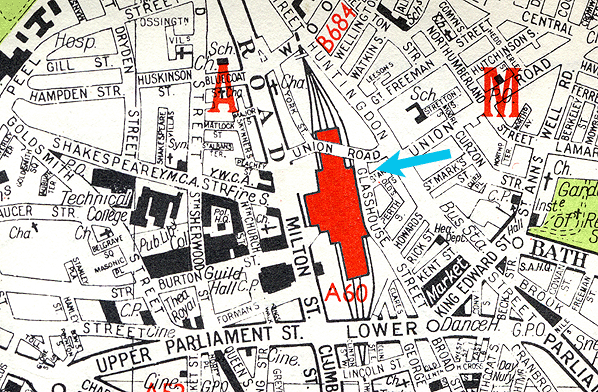
victoria_old45.jpg) Nottingham Victoria Station in c.1906
Nottingham Victoria Station in c.1906Copyright photo from John Alsop collection
johnson)victoria_old23.jpg)
Photo by Brian Johnson
victoria_old28.jpg)
Photo by Chris Ward from Chris's Train Gallery web site
victoria_old12.jpg)
Photo by Graham TV Stacey (from 30937 Photographic Group web site)
victoria10.jpg)
Photo by J E Connor
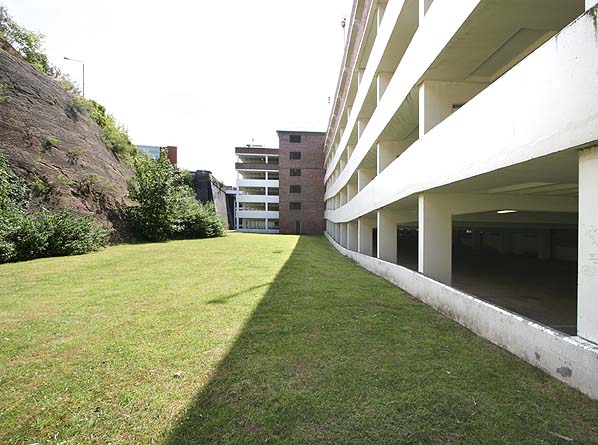
Photo by Nick Catford

|

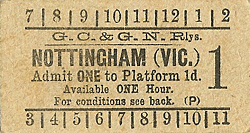
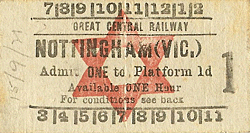
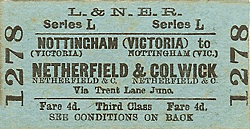
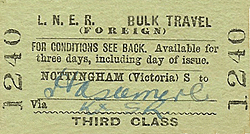


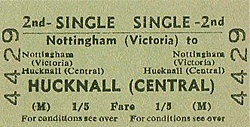
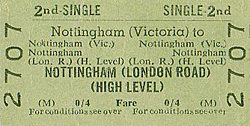

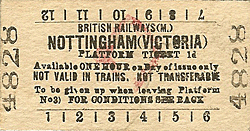
 Home Page
Home Page